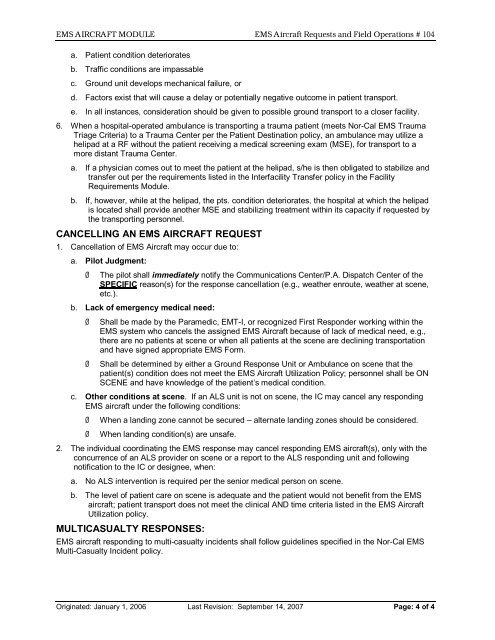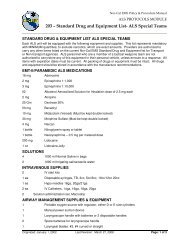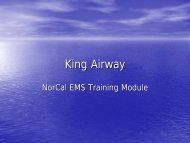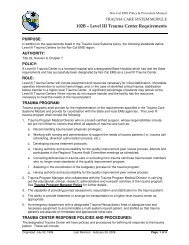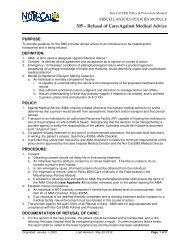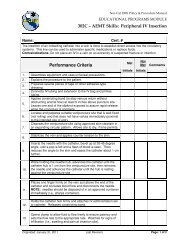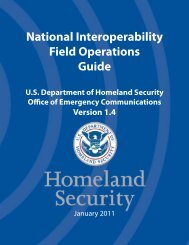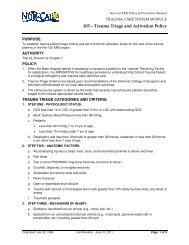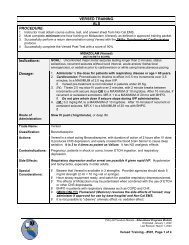Policy and Procedure Manual - Northern California Emergency ...
Policy and Procedure Manual - Northern California Emergency ...
Policy and Procedure Manual - Northern California Emergency ...
You also want an ePaper? Increase the reach of your titles
YUMPU automatically turns print PDFs into web optimized ePapers that Google loves.
EMS AIRCRAFT MODULE EMS Aircraft Requests <strong>and</strong> Field Operations # 104<br />
a. Patient condition deteriorates<br />
b. Traffic conditions are impassable<br />
c. Ground unit develops mechanical failure, or<br />
d. Factors exist that will cause a delay or potentially negative outcome in patient transport.<br />
e. In all instances, consideration should be given to possible ground transport to a closer facility.<br />
6. When a hospital-operated ambulance is transporting a trauma patient (meets Nor-Cal EMS Trauma<br />
Triage Criteria) to a Trauma Center per the Patient Destination policy, an ambulance may utilize a<br />
helipad at a RF without the patient receiving a medical screening exam (MSE), for transport to a<br />
more distant Trauma Center.<br />
a. If a physician comes out to meet the patient at the helipad, s/he is then obligated to stabilize <strong>and</strong><br />
transfer out per the requirements listed in the Interfacility Transfer policy in the Facility<br />
Requirements Module.<br />
b. If, however, while at the helipad, the pts. condition deteriorates, the hospital at which the helipad<br />
is located shall provide another MSE <strong>and</strong> stabilizing treatment within its capacity if requested by<br />
the transporting personnel.<br />
CANCELLING AN EMS AIRCRAFT REQUEST<br />
1. Cancellation of EMS Aircraft may occur due to:<br />
a. Pilot Judgment:<br />
‣ The pilot shall immediately notify the Communications Center/P.A. Dispatch Center of the<br />
SPECIFIC reason(s) for the response cancellation (e.g., weather enroute, weather at scene,<br />
etc.).<br />
b. Lack of emergency medical need:<br />
‣ Shall be made by the Paramedic, EMT-I, or recognized First Responder working within the<br />
EMS system who cancels the assigned EMS Aircraft because of lack of medical need, e.g.,<br />
there are no patients at scene or when all patients at the scene are declining transportation<br />
<strong>and</strong> have signed appropriate EMS Form.<br />
‣ Shall be determined by either a Ground Response Unit or Ambulance on scene that the<br />
patient(s) condition does not meet the EMS Aircraft Utilization <strong>Policy</strong>; personnel shall be ON<br />
SCENE <strong>and</strong> have knowledge of the patient’s medical condition.<br />
c. Other conditions at scene. If an ALS unit is not on scene, the IC may cancel any responding<br />
EMS aircraft under the following conditions:<br />
‣ When a l<strong>and</strong>ing zone cannot be secured – alternate l<strong>and</strong>ing zones should be considered.<br />
‣ When l<strong>and</strong>ing condition(s) are unsafe.<br />
2. The individual coordinating the EMS response may cancel responding EMS aircraft(s), only with the<br />
concurrence of an ALS provider on scene or a report to the ALS responding unit <strong>and</strong> following<br />
notification to the IC or designee, when:<br />
a. No ALS intervention is required per the senior medical person on scene.<br />
b. The level of patient care on scene is adequate <strong>and</strong> the patient would not benefit from the EMS<br />
aircraft; patient transport does not meet the clinical AND time criteria listed in the EMS Aircraft<br />
Utilization policy.<br />
MULTICASUALTY RESPONSES:<br />
EMS aircraft responding to multi-casualty incidents shall follow guidelines specified in the Nor-Cal EMS<br />
Multi-Casualty Incident policy.<br />
Originated: January 1, 2006 Last Revision: September 14, 2007 Page: 4 of 4


